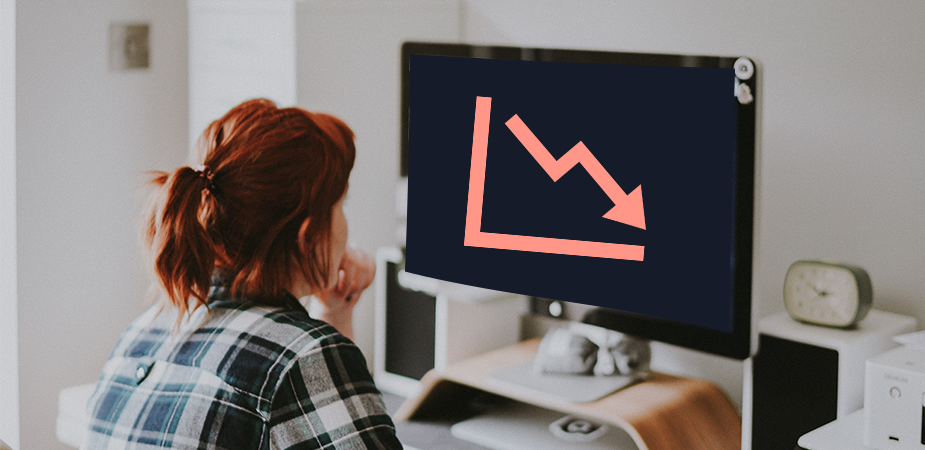Want to know if you have a conversion problem on your website?
There are three simple metrics that indicate that your website may be converting poorly.
Read on and you will understand how these metrics affect your conversion rate and exactly what to do about it.
Before we get into it, I’m going to assume you already know that Google Analytics (GA) can help you get more leads and it’s installed on your website.
Oh, you’re not using analytics?
You would probably benefit from the help, advice and expertise of a certified Google Analytics Consultant.
TL;DR (Too long; didn’t read)
- The default Google Analytics ‘conversion rate’ metric is easiest but is calculated incorrectly
- A high Bounce Rate is an indicator that your users are having a poor experience on your website
- The higher the Avg. Session Duration, the more likely someone is to convert
- The more pages viewed per session, the better impact on your conversion rate
The easiest way to measure your website conversion rate is to set up some goals in Google Analytics e.g. each time your enquiry form is submitted. Then, GA will tell you your website conversion rate.
BUT…
The Google Analytics ‘Conversion Rate’ Metric Is Wrong!
Google Analytics calculates the conversion rate as:
Goal Completions / Sessions
Why is this wrong?
Well, the problem is that 1 real-life person could visit your website on multiple occasions, creating many sessions.
As a marketer, you want to know how many people (users) you need on your website in order to get a lead, right?
So, the calculation should be:
Goal Completions / Users
Bare this in mind when you get around to setting up your website goals- something you absolutely should do.
So, assuming you don’t have your goals set up (yet) or you don’t like the default Google Analytics calculation, then let’s investigate some other metrics…
Bounce Rate
Often misunderstood, bounce rate is a good place to start when investigating a website conversion rate problem.
What is ‘bounce rate’?
A ‘bounce’ occurs when a session ends without any action having been taken. Generally speaking, this means that someone accessed your website and then left without doing anything e.g. clicking a link.
The bounce rate is calculated as:
Bounces / Sessions
At this point, it’s worth clarifying that there are positive and negative bounces. Let me explain…
Negative Bounces
A negative bounce is a symptom of a poor website user experience and generally, these happen when:
- the wrong people access your website
- the right people access your website but your website sucks
The wrong people access your website (example)
You stick an advert on Facebook telling people to click a link to your website to get a FREE iPad but when they arrive on your site they only find your Accounting business and no sign of any iPads.
These people will leave your site immediately, unimpressed.

The right people access your website but your website sucks (example)
You write an epic blog discussing and solving your target audience’s problem and share it on LinkedIn. Your ideal prospects click the link in their droves but your blog isn’t epic at all.
Just 300 words long, your blog doesn’t relate to your target audience and is just a long-winded advert for one of your services.
Positive Bounces
Bounces can occur when there is no problem and your website users have actually had a great user experience.
Typically, these might happen when:
- someone only needs some basic info and they get it, then leave
- people read your awesome blog which is purely informational and then leave
Someone only needs some basic info and they get it, then leave (example)
You have an upcoming meeting with a prospect at your office. The prospect is planning their journey and does a quick Google search for your address which leads them to your ‘Contact Us’ page.
The prospect makes a note of your postcode and closes their browser.
People read your awesome blog which is purely informational and then leave (example)
You publish an awesome, in-depth blog about ‘website conversion rate’ 😉 which explains some core industry terms and helps the reader to solve a problem on their own.
You share said blog on social media which drives people straight to the blog where they read, enjoy, and then go about implementing what you have taught them …on their own website.
How bounce rate impacts website conversion rate
Excluding positive bounces and, assuming you’re sending the right people to your website, the bounce rate can give you an indication that there is a User Experience (UX) problem with your website.
This will directly contribute to your website conversion rate.
In today’s world, human beings are incredibly impatient and will leave for a competitor’s website within seconds of a poor experience.
Think about how you interact with websites yourself, would you stay on a site if…
- It took ages to load?
- It looked old/ugly?
- It was difficult to navigate?
- The content didn’t relate to you?
These are some of the basics but in any of these scenarios, it is likely that all of those people you’ve worked so hard to send to your website will leave sharpish, increasing your bounce rate.
If people are no longer on your website because they’ve bounced, how can they convert?

What’s a high bounce rate?
Because every industry, business, and website is different, this question is not simple to answer, sorry!
However, here’s what I will say as a (very) rough guide…
- 50-70% is OK
- Below 50% is good
- Above 70% should be investigated
- Traffic from social media tends to have a higher bounce rate
- Traffic to blog posts tends to have a higher bounce rate
How to fix a high bounce rate
Unfortunately, this is where every website is different and needs its own investigation which is beyond the scope of this blog.
Because reducing your website bounce rate will contribute to an improved website conversion rate, it’s worth taking the time to investigate how it can be done.
Here’s some guidance on where to start looking…
Review the ‘Site Speed’ report
Are your pages are loading slowly (anything over a few seconds should be considered slow)?
Review the ‘Geo’ > ‘Location’ report
Are users from certain locations bouncing more than others? If your business services a local audience e.g. specific country or city then traffic from geographic areas beyond these is likely to bounce.
Review the full ‘Behaviour’ report
Identify which pages on your website are contributing to the high bounce rate. Investigate those pages further; are there loading issues? Is the content no longer relevant?
Review the ‘Acquisition’ report
Is the high bounce rate caused by traffic from a particular source? For example, if the bounce rate from social and organic traffic is 40% but your referral traffic has a bounce rate of 90%, you can investigate which websites are referring you such poor traffic.
Avg. Session Duration
When you’re thinking about your next holiday, how long does it to get to the point where you’ve paid for it?
You’re probably going to research the destination, read the reviews of the hotel, and investigate the best flight times before you even consider parting with your cash.
Depending on what your business is selling, it’s likely to be the same for your target market.
With this in mind, it’s fair to say that the longer someone is on your website, the more likely they are to convert.
What is ‘Avg. Session Duration’?
The Avg. Session Duration metric tells you, on average, how long people spend, in time, on your website each time they visit.
For example, if 1 person visits your website but leaves after 30 seconds and a 2nd person visits but stays for 3 minutes (180 seconds), your avg. session duration will be 105 seconds OR 1 min, 45 seconds (30 + 180 / 2 = 105).
What is a good Avg. Session Duration?
As with everything in this article, a good average session duration is subjective and relative to the size of your website and the service/product you’re trying to sell.
If you’re marketing a website for a small shop that sells chocolate, your target audience is unlikely to need long to decide to buy from you- nobody really wants to know the ingredients of a chocolate bar, do they?!
Conversely, if your service is particularly complex or expensive then your users will likely need substantially more convincing and therefore need to be on your website longer.
Generally speaking, the longer the better.
What causes a low Avg. Session Duration?
The answers to this are fairly obvious, which is a good thing because each of the following has very simple fixes…
- Your website users can’t find what they’re looking for and leave
- You have a small website in terms of the number of pages, or even a 1-page website
- The pages on your website are very thin on content
How to increase the Avg. Session Duration?
Remember, the goal is not to increase the average session duration, it’s to increase your conversion rate.
You don’t want people on your website watching long, pointless videos or reading irrelevant blogs. Both of these things would probably increase the amount of time people spend on your website but for no real benefit to your business.
A longer session duration on a site that is filled with useful, relevant content will definitely contribute to a better conversion rate.
With this in mind, you should complete a content audit of your website.
Website Content Audit
A good place to start here is to ask your sales team a few questions:
- What are the top 5 questions you are always asked about X product/service?
- What terminology do you always have to explain to a prospect?
- What are the most common objections prospects have in relation to X product/service?
- What features and benefits are prospects most interested in?
Repeat the above questions for every product/service and then repeat the whole process with each member of the sales team.
Once you have your answers, is your website providing the information that your target audience is looking for?
You will most likely discover some gaps in your website content.
You may need to add some new pages, split up old pages, or just add some new content to existing pages.
Remember, when adding your content, keep your user in mind- they’re unlikely to read long swathes of copy.
Use different formats e.g. lists, FAQ, images, infographics, videos, etc. to keep your content interesting.
Pages/Session
The final piece in this puzzle of understanding which basic metrics contribute to your conversion rate is the average number of pages viewed per session.
Similar to the avg. session duration, if someone is going to buy from you (& you’re not selling chocolate bars), they’re likely to want to digest a fair amount of information before they make that decision.
Let’s go back to the example of booking a holiday. When looking at a hotel website, you’re probably going to look at a number of different pages before deciding to book e.g. the various room types, the menu of the restaurant, the hotel facilities, etc.
It will be no different for your prospective clients.
What is ‘pages/session’?
Pretty self-explanatory, pages/session is the average number of pages viewed each time your website is accessed.
Typically, you will want this to be as high as possible but within context- having people dart all over your website between unrelated pages is likely to be a sign of a poor user experience.
What causes low pages/session?
If you feel that not enough of your pages are being viewed each time someone visits your website, this is likely to be caused by only a couple of things…
Poor Navigation
If your website is too difficult to navigate, you’re making it challenging for people to find the content they’re looking for and they will likely leave for a competitor’s site.
Poor navigation is caused by an overly-complicated menu, confusing page names/links, and pages that are too hard to find because it requires clicking 4 previous links to reach it.
Lack of Clear Calls to Action (CTA)
‘Don’t make me think’ is a phrase that you should cement in your mind as well as an excellent book on web usability that you should read.
Simply put, if a user has to think in order to use your website, you have created a poor user experience.
For example, if someone gets to the bottom of a page on your website and it’s not clear what they should do next, they then have to engage their brain to think for themselves.
Thinking requires energy and we have far more important things to think about than how to use your website.
This example would likely cause people to leave your website.
Where is the big red button that says CLICK ME?
You should ensure that each page on your website links intuitively to the next. What content will your users want to see next?
Make it easy.
Summary
There are many more indicators that you might have a conversion-rate problem on your website but start with these three metrics to highlight any core issues causing your visitors not to buy from you.
The most important thing is that you are tracking this data and analysing it regularly.
Many marketers admit to not having the time to review their website analytics and if this is you, consider hiring a Google Analytics Consultant to do the work for you!
Who doesn’t want to be responsible for making their business more money?!
If you struggle with website analytics and conversion rate optimisation or would just like to ask some basic questions then please send me an email.




